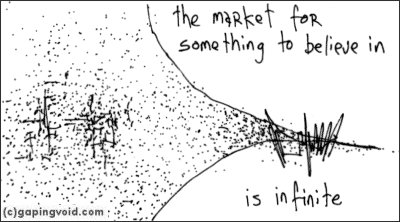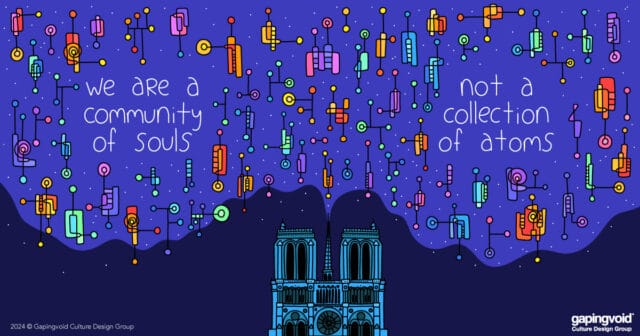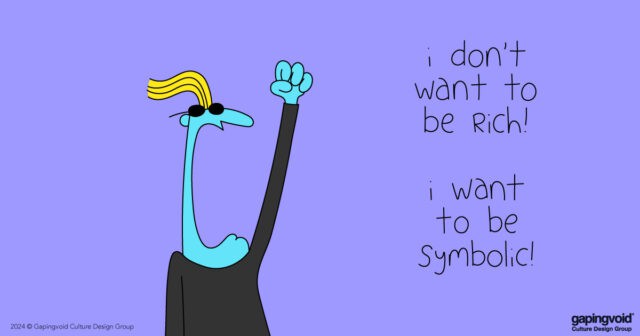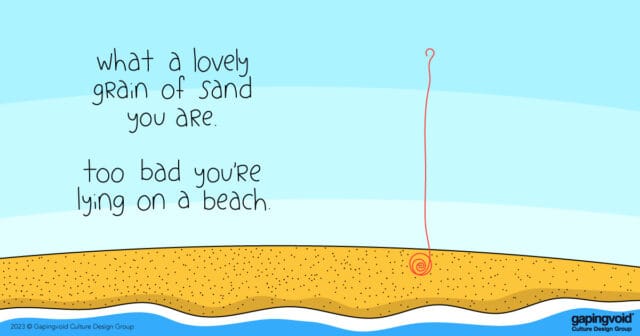
[Back in 2004, I tried merging The Cluetrain with the ad industry, perhaps a couple of years before the world was really ready. Heh.]
One of gapingvoid’s favorite collectors, Havas International CEO David Jones wrote a nice article in Advertising Week recently about how we need to kill the idea of “consumer”, replacing it with far more straightforward idea of “people” and/or “customer”. You know, making advertising and business more human, less sociopathic etc.
This humanizing of business via language and technology (which at its best, is what advertising really is) is what The Cluetrain Manifesto was also talking about, all those years ago.
1. Markets are conversations.
2. Markets consist of human beings, not demographic sectors.
3. Conversations among human beings sound human. They are conducted in a human voice.
Whether delivering information, opinions, perspectives, dissenting arguments or humorous asides, the human voice is typically open, natural, uncontrived.
This is why it was such an important book, back in the early dotcom era. They were right, in the end.
In their own way, David and his colleagues at Havas are trying to channel this kind of Cluetrain thinking (which I applaud) with their “#MeaningfulBrands” initiative, which coincidentally, another favorite Twitter buddy of mine, Umair Haque is heavily involved with. Small world…
Here’s their thinking: It turns out that “Meaningful” brands outperform the market by a very wide margin (120%), which besides being amazing, seems like some sort of poetic justice, for those of us in the business world who see our careers as more than just chasing numbers and job titles.
So the #MeaningfulBrands premise seems fairly straightforward: “Look, by helping to make your brand more meaningful, to both you and the outside world, Havas can deliver a TON of value on a global scale. For a lot less money than it would cost to deliver the same-old-same-old.”
That’s great. There’s just one question:
What is “Meaningful”, exactly?
How do you know if your brand is meaningful, or at least, more meaningful than the nearest competitor?
What does is it all “mean”? It’s all very relative, very vague and wooly, isn’t it?
Well, I’ve been watching brands, gapingvoid’s included, for a very long time. I think I know what makes brands meaningful.
No, it isn’t price. No it isn’t quality. No, it isn’t all those new sexy new features that brand managers love to yak on about. Those are just “stuff”, they’re not the magic.
The magic, the first real sign of a meaningful brand, is they tend to have fantastic customers.
Read that last sentence one more time.
i.e. Their customers tend to rock.
Think about an interesting brand, a REALLY interesting one, by whatever criteria you choose.
Question: Who uses them? The short answer is: Interesting people. This is especailly true in the early days of the brand’s lifetime.
Brands become interesting to us once interesting people start using them, not the other way around.
i.e. A brand is made meaningful by the human interaction around it, not by the object itself.
i.e. Everything comes down to people, in the end.
By getting more genuinely interested in people, interested in their true selves (as opposed to some sort of technocratic consumer-cipher abstraction), your brand will get more meaningful and profitable over time.
A decade after Cluetrain, I am happy to finally be able to report, it seems the global ad agencies (like Havas) are finally trying to catch up.
This is what #MeaningfulBrands says to me, anyway…



